Conversation with Editor-in-Chief Series
In this webinar, IMRE invites Editors-in-Chief from prestigious journals to share tips and tricks of writing successful research articles for publications.
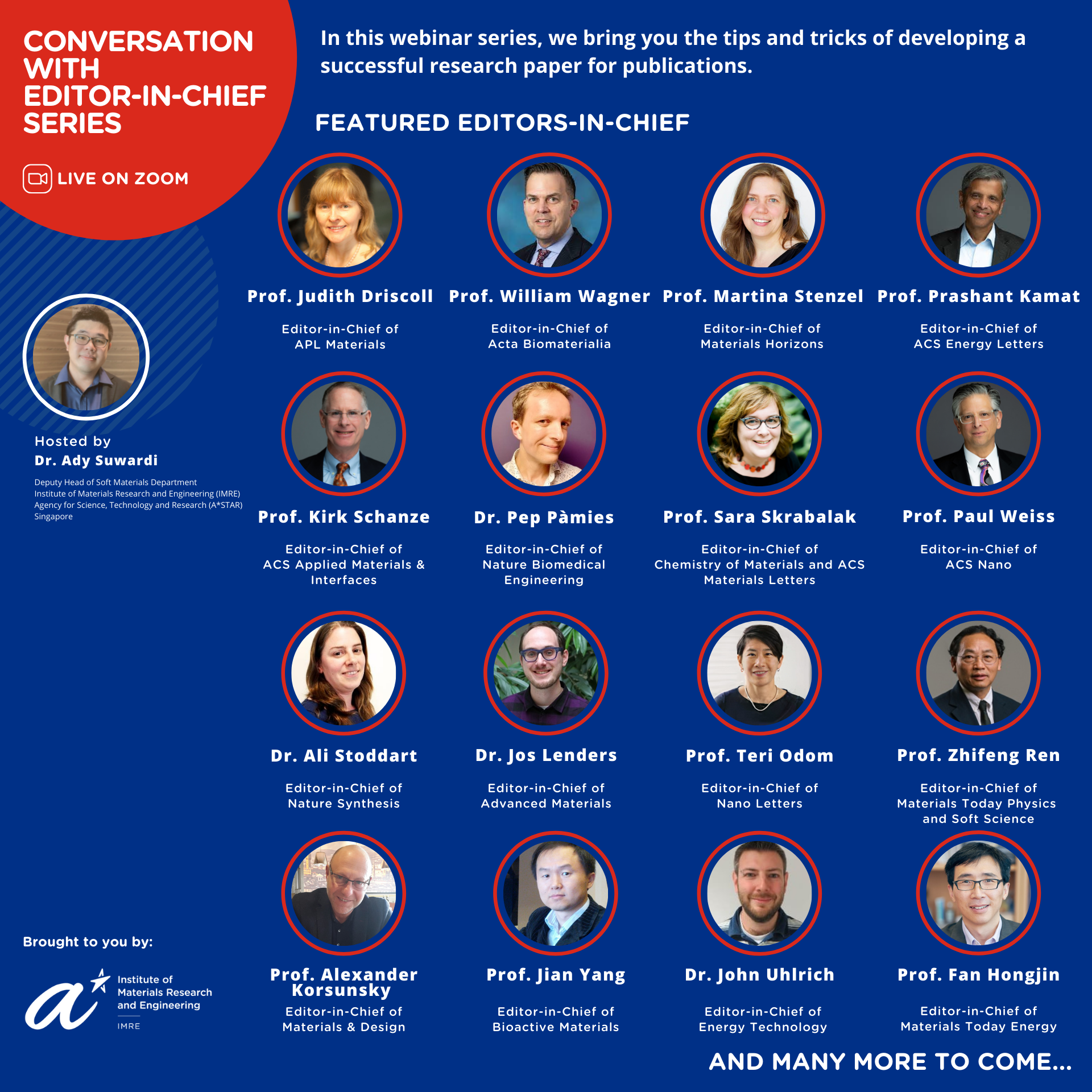
Stay tuned for more information on the speakers lined up.
PAST WEBINAR
4:45pm to 5:30pm
(SG Time)

Prof. William R. Wagner
Editor-in-Chief of Acta Biomaterialia
Biography
Dr. William R. Wagner holds a B.S. (Johns Hopkins, 1986) and Ph.D. (University of Texas, 1991) in chemical engineering and has been on the faculty at the University of Pittsburgh since 1991. He is a Professor of Surgery, Bioengineering and Chemical Engineering and serves as Director of the McGowan Institute for Regenerative Medicine. Dr. Wagner is the Founding Editor and Editor-in-Chief of Acta Biomaterialia, which has quickly grown to be one of the leading journals in the biomaterials field. His research group works in the area of cardiovascular engineering with projects that address medical device biocompatibility and design, biomaterials and tissue engineering, and targeted imaging. Research activities range from modeling and in vitro studies to clinical research. Dr. Wagner is a past President of the American Society for Artificial Internal Organs (ASAIO; 2010) and serves on the Executive Board of the International Federation of Artificial Organs (IFAO; 2009). He is a fellow and former vice president of the American Institute for Medical and Biological Engineering (AIMBE; 2000) and has also been elected a fellow of the Biomedical Engineering Society (BMES; 2007), American Heart Association (2001), and the International Union of Societies for Biomaterials Science and Engineering (IUSBSE; 2008). In 2009 he was selected as the Society for Biomaterials representative to the IUSBSE. He has served as Chairman for the Gordon Research Conference on Biomaterials: Biocompatibility & Tissue Engineering as well as for the First World Congress of the Tissue Engineering and Regenerative Medicine International Society (TERMIS). Recently, he was selected as Chairman for the 2013 BMES Annual Meeting and as the TERMIS Chair-Elect of the Americas Region. His recent recognitions have included the 2011 Society for Biomaterials Clemson Award for Applied Research and the 2012 Chancellor’s Distinguished Research Award from the University of Pittsburgh. Dr. Wagner’s research has generated numerous patents and patent filings that have resulted in licensing activity, the formation of a company, and University of Pittsburgh Innovator Awards in 2007, 2008, 2009, and 2010.
About Acta Biomaterialia
Acta Biomaterialia is an international journal that publishes peer-reviewed original research reports, review papers and communications in the broadly defined field of biomaterials science. The emphasis of the journal is on the relationship between biomaterial structure and function at all length scales.
The scope of Acta Biomaterialia includes:
- Hypothesis-driven design of biomaterials
- Biomaterial surface science linking structure to biocompatibility, including protein adsorption and cellular interactions
- Biomaterial mechanical characterization and modeling at all scales
- Molecular, statistical and other types of modeling applied to capture biomaterial behavior
- Interactions of biological species with defined surfaces
- Combinatorial approaches to biomaterial development
- Structural biology as it relates structure to function for biologically derived materials that have application as a medical material, or as it aids in understanding the biological response to biomaterials
- Methods for biomaterial characterization
- Processing of biomaterials to achieve specific functionality
- Materials development for arrayed genomic and proteomic screening
9:15am to 10:15am
(SG Time)
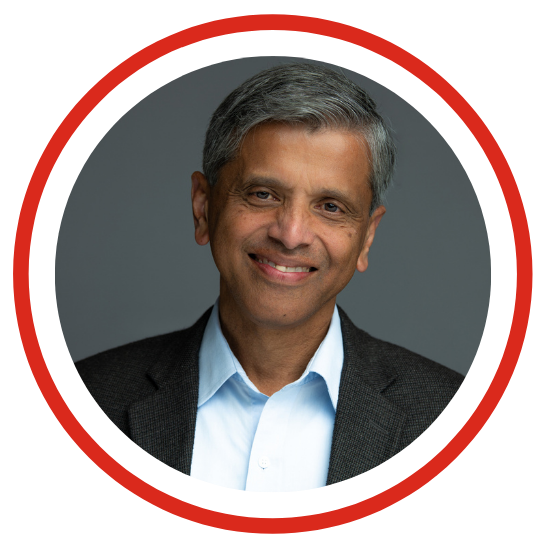
Prof. Prashant Kamat
Editor-in-Chief of ACS Energy Letters
Biography
Professor Kamat earned his doctoral degree in Physical Chemistry from the Bombay University (1979), and carried out postdoctoral research at Boston University (1979-1981) and the University of Texas at Austin (1981-1983). He joined the Radiation Laboratory at the University of Notre Dame in 1983 and initiated a project on utilizing semiconductor nanostructures for light energy conversion. He is currently a Professor of Chemistry and Biochemistry at Notre Dame. He has published more than 350 papers in peer reviewed journals. He has edited two books on nanostructured materials. He served as the Deputy Editor of The Journal of Physical Chemistry Letters from 2010 to 2016.
About ACS Energy Letters
ACS Energy Letters publishes papers that report new scientific advances in all aspects of energy research that are of interest to scientists working in the fundamental, and applied sciences. A central criterion to acceptance is that the paper reports sufficiently urgent results such that rapid publication is essential. ACS Energy Letters is published monthly.
Journal editors and staff routinely attend major scientific conferences, and are eager to discuss the journal with readers and authors, and the journal maintains an active presence on social media.
4:15pm to 5:15pm
(SG Time)

Prof. Alexander M. M. Korsunsky
Editor-in-Chief of Materials and Design
Biography
Alexander received his DPhil in Engineering Science from Merton College, University of Oxford in 1995. He then held a Junior Research Fellowship at Fitzwilliam College, Cambridge. In 1999, he returned to Oxford to lead his own research group in the Department of Engineering Science, focusing on the study of materials structure and processes using optical, electron, ion, neutron and X-ray beams.
He is Fellow of Trinity College and Fellow of the Institute of Physics, UK, and member of EPSRC peer review college. He is Senior Visiting Scientist at Diamond Light Source (UK synchrotron), where he has been named a 'leading light' for his contributions to UK X-ray science.
About Materials and Design
Materials and Design publishes original research reports, review articles and express communications covering the studies of structure and properties of inorganic and organic materials, advances in synthesis, processing, characterisation and testing, design of materials and engineering systems, and applications in technology. The journal is multi-disciplinary in nature, and seeks to bring together aspects of materials science, engineering, physics, and chemistry. In exploring the themes ranging from materials to design, it also pursues the elucidation of underlying connections between natural and artificial, and experiment and modelling.Manuscripts submitted to Materials and Design are sought to contain elements of discovery and surprise that often accompany the obtention of new insights into the architecture and function of matter.
4pm to 5pm
(SG Time)

Dr. Jos Lenders
Editor-in-Chief of Advanced Materials
Biography
Dr. Jos Lenders is the Editor-in-Chief of Advanced Materials. He studied chemical engineering with a minor in biomedical engineering and a master in polymers and composites at Eindhoven University of Technology (in the Netherlands), where he also obtained his PhD in the area of bioinspired materials chemistry and advanced electron microscopy. He joined Wiley in 2015 and has since edited a number of journals in the Advanced family, including Advanced Functional Materials, Advanced Healthcare Materials, and Advanced Therapeutics.
Advanced Materials is a weekly peer-reviewed scientific journal covering materials science. It includes communications, reviews, and feature articles on topics in chemistry, physics, nanotechnology, ceramics, metallurgy, and biomaterials. According to the Journal Citation Reports, the journal has a 2020 impact factor of 30.849.
5pm to 6pm
(SG Time)
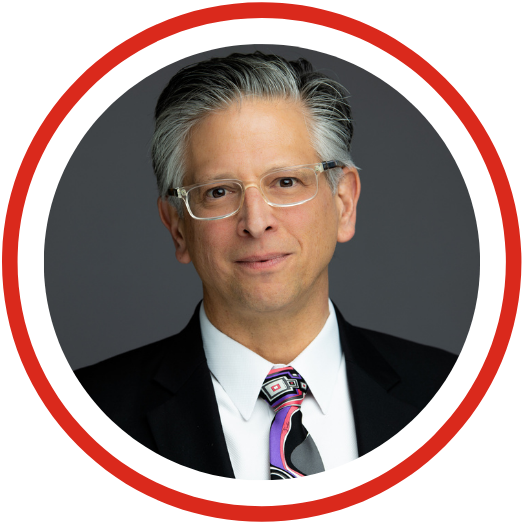
Prof. Paul S. Weiss
Editor-in-Chief of ACS Nano
Biography
Prof. Paul S. Weiss holds a UC Presidential Chair and is a distinguished professor of chemistry & biochemistry, bioengineering, and materials science & engineering at UCLA. He received his S.B. and S.M. degrees in chemistry from MIT in 1980 and his Ph.D. in chemistry from the University of California at Berkeley in 1986. He was a postdoctoral member of technical staff at Bell Laboratories from 1986-88 and a visiting scientist at IBM Almaden Research Center from 1988-89. He served as the director of the California NanoSystems Institute and held the Fred Kavli Chair in NanoSystems Sciences at UCLA from 2009-14. Before coming to UCLA, he was a distinguished professor of chemistry and physics at the Pennsylvania State University, where he began his academic career in 1989. His interdisciplinary research group includes chemists, physicists, biologists, materials scientists, mathematicians, bioengineers, electrical and mechanical engineers, computer scientists, clinicians, and physician scientists. They focus on the ultimate limits of miniaturization, exploring the atomic-scale chemical, physical, optical, mechanical, and electronic properties of surfaces, interfaces, supramolecular, and biomolecular assemblies. They develop new techniques to expand the applicability and chemical specificity of scanning probe microscopies. They apply these and other tools to study self- and directed assembly, and molecular and nanoscale devices. They advance nanofabrication down to ever smaller scales and greater chemical specificity to operate and to test functional molecular assemblies, and to connect to the chemical and biological worlds in neuroscience, gene editing, cancer immunotherapy, tissue engineering, and the microbiome. He has written over 400 publications, holds over 30 patents, and has given over 800 invited, plenary, keynote, and named lectures.
ACS Nano (2020 Impact Factor: 15.881, Nature Index Journal List) is an international forum for the communication of comprehensive articles on nanoscience and nanotechnology research at the interfaces of chemistry, biology, materials science, physics, and engineering. Moreover, the journal helps facilitate communication among scientists from these research communities in developing new research opportunities, advancing the field through new discoveries, and reaching out to scientists at all levels.
11am to 12pm
(SG Time)
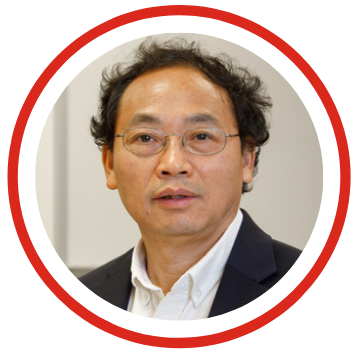
Prof. Ren Zhifeng
Editor-in-Chief of Materials Today Physics and Soft Science
Biography
Professor Ren Zhifeng is the Editor-in-Chief of Materials Today Physics and Soft Science. He also sits in the editorial board for many journals such as npj Quantum Materials and Materiomics. Prof. Ren Zhifeng received his Ph.D. in condensed matter physics from the Institute of Physics, Chinese Academy of Sciences, Beijing, China. Prof. Ren is now a Professor at the Department of Physics in the University of Houston, Texas – USA and the Director of the Texas Center for Superconductivity. His research interests are in high performance thermoelectric materials and solar energy conversions, flexible transparent electrodes and carbon nanotubes and nanocomposites, amongst many others. In 2018, Prof. Ren has been awarded as a highly cited Researcher in physics by the Clarivate Analytics and the Humboldt Research Award from the Alexander von Humboldt Foundation. As of Aug. 1st, 2021, Dr. Ren has published close to 600 peer-reviewed papers, with a h-index of 131 and citations of more than 80000.
Materials Today Physics by Elsevier (IF. 9.298) is a multi-disciplinary journal dedicated to the physics of materials. It spans all aspects of materials physics, including condensed matter physics, solid mechanics, photonics and optical properties. The topics include functional materials, quantum materials and electronics materials, among many others.
About Soft Science
Soft Science is new journal launched very recently for research on mechanically deformable, flexible, or stretchable materials and devices. The rising interest in soft materials and electronic device has enabled the growth of specialized journals focusing soft materials and devices applications for healthcare, medicine, robotics, and the internet of thing (IoT). Soft Science aims to be a high-profile and specialized platform that publishes high-quality papers on mechanically soft systems on a variety of scales, ranging from materials (e.g., hydrogels) to devices (e.g., flexible electronics) to functional systems (e.g., soft robotics).
4.30pm to 5.30pm
(SG Time)
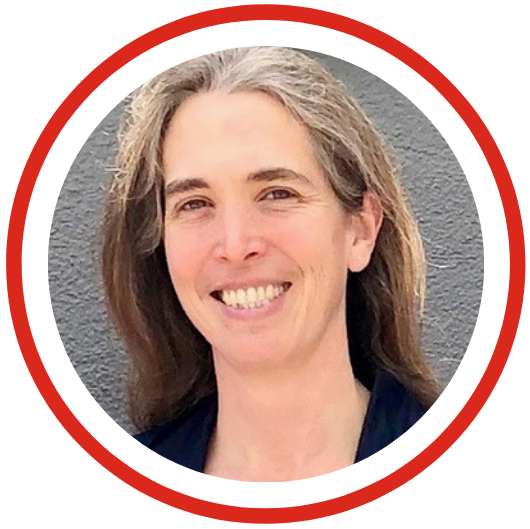
Dr. Theresa Kueckmann
Editor-in-Chief of Chemistry – An Asian Journal and Executive Editor of Angewandte Chemie
Biography
Theresa Kueckmann studied chemistry at the University of Minnesota, conducting research on bioinorganic model complexes in the group of Bill Tolman. She then moved to Germany, where she completed an MS at the Freie Universität Berlin, doing research on rhenium oxo complexes for radiopharmaceutical therapy with Ulrich Abram. She was awarded her PhD by the Goethe-Universität Frankfurt for a thesis on transition-metal complexes of silylchalcogenolates with Matthias Wagner. She joined Wiley-VCH in 2007 and worked five years at Angewandte Chemie before being named Editor of Chemistry—An Asian Journal in 2012. Since 2015, she has taken on the additional role of Editor of ChemNanoMat, and since 2017, the role of Editor of Asian Journal of Organic Chemistry. Currently she is the editor-in-chief of Chemistry – An Asian Journal, and concurrently the executive editor of Angewandte Chemie.
Chemistry—An Asian Journal publishes articles and reviews on all aspects of chemistry, including organic and inorganic chemistry, biochemistry, physical and analytical chemistry, as well as interdisciplinary topics such as energy storage and conversion and materials science. Chemistry—An Asian Journal is published on behalf of the Asian Chemical Editorial Society (ACES), an association of numerous Asian chemical societies.
About Angewandte Chemie
Angewandte Chemie is a journal of the German Chemical Society (GDCh). With an excellent Impact Factor of 15.336 (2020), the journal is maintaining its leading position among scholarly journals with a focus on general chemistry. It appears weekly in a highly optimized, reader-friendly format; new articles appear online almost every day. Founded in 1887, Angewandte Chemie is one of the prime chemistry journals in the world today. Moreover, it is the only journal in the field delivering a stimulating mixture of Review-type articles, Highlights, Communications, and Research Articles weekly.
10 am to 11 am
(SG Time)
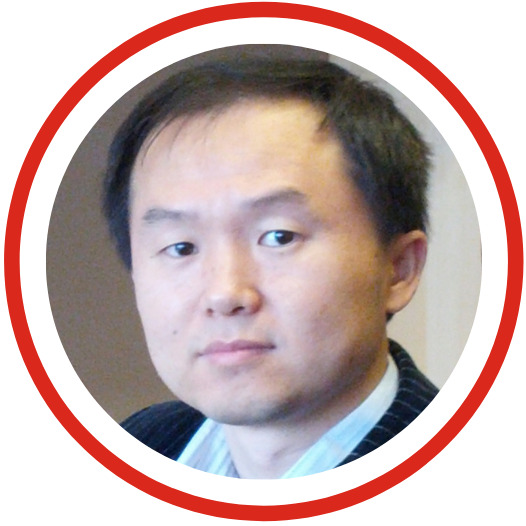
Prof. Jian Yang
Editor-in-Chief of Bioactive Materials
Biography
Dr. Yang is a professor in the Department of Biomedical Engineering and Lloyd & Dorothy Foehr Huck Chair in Regenerative Engineering at Pennsylvania State University (PSU). Dr. Yang’s research contributes to the innovation of citrate-based biomaterials and their applications in tissue engineering, drug delivery, biosensing, and bioimaging. Dr. Yang is also serving as a Co-Editor-in-Chief for "Bioactive Materials" (2020 IF 14.593), an Associate Editor for "Frontiers in Bioengineering and Biotechnology, Biomaterials section", and an Editorial Board Member for ACS Biomaterials Science and Engineering, and Applied Materials Today.
Bioactive Materials is an international, peer-reviewed research publication covering all aspects of bioactive materials. The journal welcomes the submission of research papers, reviews and rapid communications that are concerned with the science and engineering of next-generation biomaterials that come into contact with cells, tissues or organs across all living species. Bioactive materials will feature adaptiveness to the biological environment, being designed to stimulate and/or direct appropriate cellular and tissue responses, or control interactions with microbiological species.
4pm to 5pm
(SG Time)

Dr. John Uhlrich
Editor-in-Chief of Energy Technology
Title
Publishing Scientific Research and How to Write High-Impact Scientific Papers
Abstract
From the perspective of an editor, John Uhlrich (Editor-in-Chief, Energy Technology) will present on the current state of publishing in energy research and the physical sciences, including chemistry, materials science, and engineering, by outlining the roles, responsibilities, and ethical obligations of authors, editors, and reviewers. The talk will include tangible examples and how-to's related to publishing in journals and what editors look for when evaluating a manuscript submission. An introduction to the Wiley-VCH journals will be presented along with some tips for preparing scientific publications and how to achieve the highest possible impact after publication.
Biography
John Uhlrich obtained his Ph.D. in Chemical Engineering from the University of Wisconsin-Madison (USA) in the group of Prof. Thomas Kuech and worked as a postdoctoral scientist at the Fritz Haber Institute (Berlin, Germany) in the Department of Chemical Physics under Prof. Hans-Joachim Freund. In 2011 he joined the editorial office of the materials science journal Advanced Materials at Wiley-VCH in Weinheim, Germany. In 2012, he launched the journal Energy Technology, accepting the role of the journal's Editor-in-Chief in 2016. John also currently holds editorial positions with Advanced Energy Materials, Advanced Materials Interfaces, and Advanced Functional Materials, in addition to managing the externally edited journal Fuel Cells.
Energy Technology was established in 2013 as a peer-reviewed scientific journal on applied energy research, publishing the latest advances in energy generation, conversion, storage, and distribution. The journal has developed quickly into an important resource for the energy science and engineering community. According to the Journal Citation Reports, the journal has a 2020 Impact Factor of 3.631.
4pm to 5pm
(SG Time)

Prof. Richard Hoogenboom
Editor-in-Chief of European Polymer Journal
Biography
Prof. Richard Hoogenboom is heading the Supramolecular Chemistry (SC) group that was founded based on his appointment as associate professor in 2010 (full professor since 2014). He obtained a PhD from Eindhoven University of Technology under supervision of Prof. Ulrich S. Schubert and performed postdoctoral research with Prof. Martin Möller (RWTH Aachen) and Prof. Roeland Nolte (Radboud University Nijmegen). Prof. Hoogenboom has published more than 430 refereed scientific articles and received 20,000+ citations (h-index 65) and is listed as inventor on 21 patent families. He is currently editor-in-chief for European Polymer Journal and associate editor for Australian Journal of Chemistry. Prof. Hoogenboom is the recipient of the inaugural RSC Polymer Chemistry award (2015), the PI IUPAC young investigator award (2016), the Prometheus award for research from Ghent University (2016), the ACS Macromolecules/Biomacromolecules Young Investigator award (2017) and the ACS Carl S. Marvel Creative Polymer Chemistry Award. Since January 2018, Prof. Hoogenboom is a cofounder of Avroxa BVBA that commercialized poly(2-oxazoline)s as Ultroxa.
About European Polymer Journal
European Polymer Journal is dedicated to publishing work on fundamental and applied polymer chemistry and macromolecular materials. The journal covers all aspects of polymer synthesis, including polymerization mechanisms and chemical functional transformations, with a focus on novel polymers and the relationships between molecular structure and polymer properties. In addition, we welcome submissions on bio-based or renewable polymers, stimuli-responsive systems and polymer bio-hybrids. European Polymer Journal also publishes research on the biomedical application of polymers, including drug delivery and regenerative medicine. The main scope is covered but not limited to the following core research areas:
Polymer synthesis and functionalization
- Novel synthetic routes for polymerization, functional modification, controlled/living polymerization and precision polymers.
Stimuli-responsive polymers
- Including shape memory and self-healing polymers.
Supramolecular polymers and self-assembly
- Molecular recognition and higher order polymer structures.
Renewable and sustainable polymers
- Bio-based, biodegradable and anti-microbial polymers and polymeric bio-nanocomposites.
Polymers at interfaces and surfaces
- Chemistry and engineering of surfaces with biological relevance, including patterning, antifouling polymers and polymers for membrane applications.
Biomedical applications and nanomedicine
- Polymers for regenerative medicine, drug delivery molecular release and gene therapy
A*STAR celebrates International Women's Day

From groundbreaking discoveries to cutting-edge research, our researchers are empowering the next generation of female science, technology, engineering and mathematics (STEM) leaders.
Get inspired by our #WomeninSTEM
.png?sfvrsn=b59474e9_3)